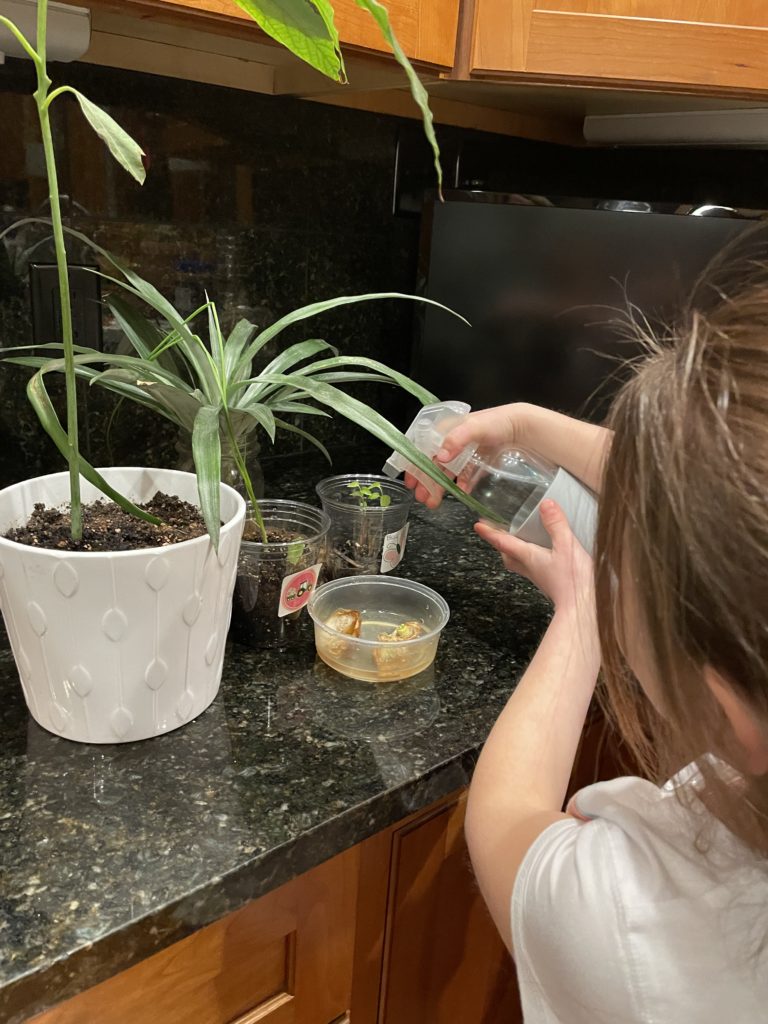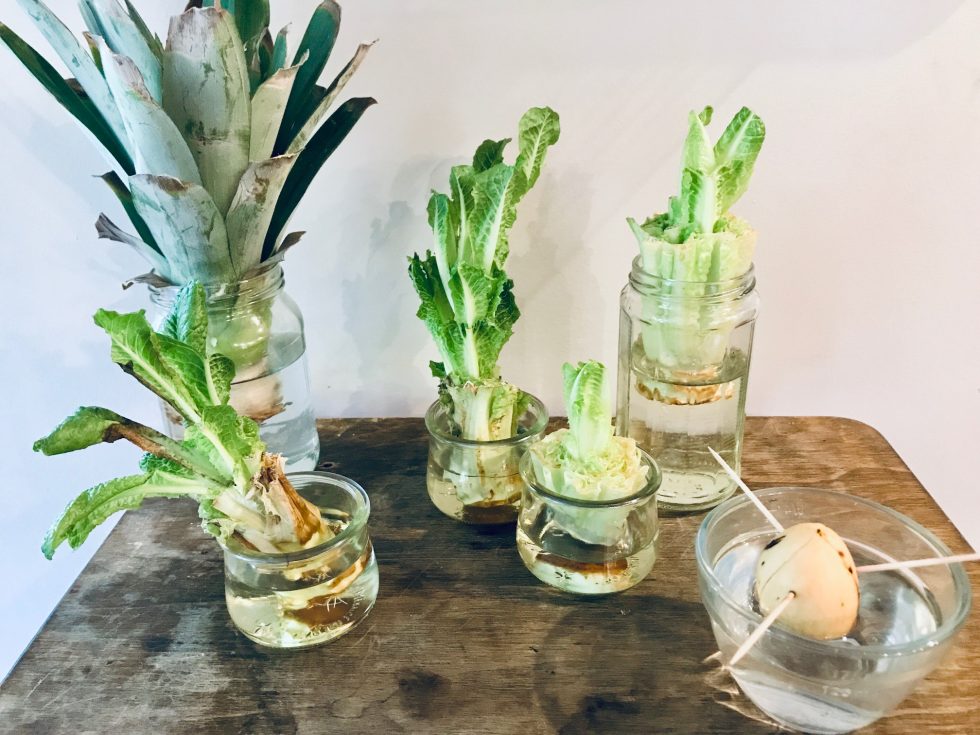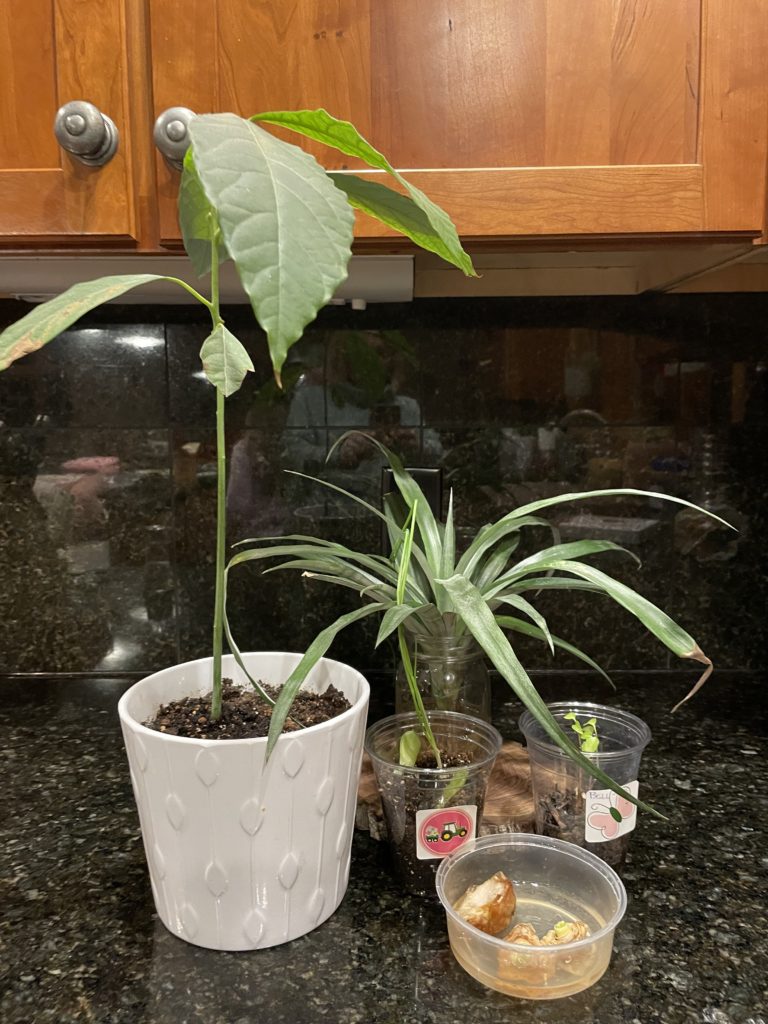Scrap Gardening for STEM Learners
“Did the lettuce sprout today?” asks Jamie as he enters the classroom, heading over to our classroom “scrap garden” to see for himself without stopping to take off his coat.
“It has!” squeals Evelyn, her eyes wide with excitement. “You won’t believe how high it has grown!”

Our investigation into scrap gardening has clearly taken root!
Scrap gardening is the practice of growing plants from items that you’d normally toss out.
Almost like magic, lettuce can be regrown from its base in a container of shallow water with a little sunshine and a little bit of time.
Children are fascinated by the process of regeneration as they watch fruit and vegetable scraps once destined for the garbage or compost bin take root and grow into something that can be eaten and then replanted once again.

Gardening is a great way to incorporate sensory exploration into your science lessons. Young children learn through their senses, and this science experiment offers a wealth of sensory opportunities.
Children use their eyes to perceive the different shapes and colors of leaves. They use their sense of smell to perceive the scents of different types of plants. They use their sense of touch to see how the leaves and roots feel or check the water level.
And nothing beats using their sense of taste to explore the different flavors of homegrown produce as they feast on the fruits of their labors. After all, half the fun of gardening is getting to eat what you grow!
Here’s another bonus: Studies show that students involved in hands-on school gardening programs are more likely to snack on healthy fruits and vegetables.

“Is it my turn to check the plants and water them?” Violet asks.
“I bet the basil needs some water, too!” Lauren responds, looking for any excuse to play with water.
We grow plants throughout the year in our classroom and in our outdoor garden. The children enjoy rubbing the leaves of different plants to release their scents, incorporating plants into cooking projects and snacking on them straight off the vine.

“Do you think there’s enough sunshine here?” asks Isabella.
Gardening moments like these naturally prompt children to ask questions and engage in scientific inquiry. Gardening activities also promote cognitive development, help build a foundation of early science skills and introduce science vocabulary words such as “experiment,” “procedures,” “observations,” “hypothesis” and “evaporation.”
Children can measure and record the growth of the garden scraps and introduce variables by growing different types of plants and exposing them to more or less sunshine.
Scrap gardening is also a great way to show children where food comes from and teach them about the life cycles of plants.
Supplies you will need to regrow your lettuce scraps:
- Romaine lettuce
- Toothpicks
- Shallow bowl or container
- Knife
- Water
- Sunlight
Cut your lettuce about three inches from the base and place the bottom of the stalk in an inch of water. There should be just enough water in the bowl to cover the bottom third of your lettuce core.
You may need to use toothpicks to balance your lettuce core, depending on the size and shape of your container. Use only a small amount of water to prevent rot. Keep the bowl in a sunny area and change the water daily. The process of growing plants from leftovers can be fun and rewarding, but it does require a bit of patience.
That’s why we like to use romaine lettuce. In just a few days, you will start to notice sprouts and small leaves emerging from the very center of the stalk. In about a week, you may see small stalks and leaves, as well as tiny roots, growing out of the base. The cut stalks may begin to deteriorate and turn brown around the outer base. This is normal. You can continue to grow the lettuce in the water or transplant the sprouted hearts directly into the garden. Pinch off the outer leaves as the lettuce grows for baby greens. Harvest the romaine lettuce when it’s about 6 to 8 inches tall.

Kitchen scrap gardening is also a great way to teach children about plant parts, as well as the importance of recycling and reusing the earth’s limited resources.
With spring just around the corner, this may be the perfect way to prepare for the growing season while waiting for the snow to melt.
Now that you’ve read my post, check out these free Classroom Garden, Plant Journal and Growing Lettuce from Scraps lesson plans!
Happy gardening!
This looks like a great idea to continue growing the items we have planted in our garden.
the children loved growing our plants that we had already snacked off of, they love the tomato
Thanks for sharing, Jill! I heard from another educator that their cafeteria employees started Scrap Gardening with a first grade class and took the whole school by storm! It grew community among the school, the children happily ate their fresh grown veggies, educators started using the garden for math and science…she just went on and on! One man’s trash can be one school’s treasure!!